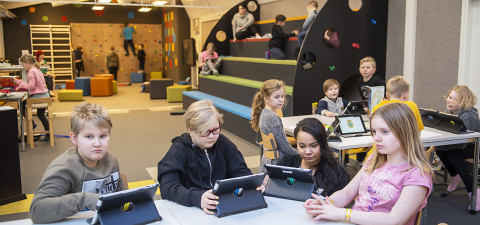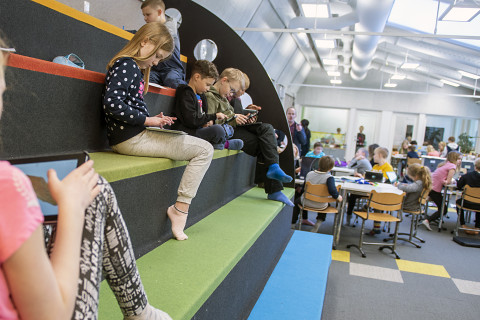This spring has witnessed an interesting PhD project at the Tulliportti Teacher Training School in Joensuu. Researchers have been working together with fifth graders to identify spaces that foster learning in the school’s open-plan learning environment. In addition to pupils’ own feelings, the study also makes use of brain wave data.
The goal of the on-going study is to explore pupil behaviour and learning in an open-plan learning environment, which the fifth graders have been using for a little over a year now.
“Since this is a large, novel and flexible environment with roughly 70 pupils studying here, we wanted to identify the spaces where pupils can concentrate and commit to their studies,” says Lecturer Ulla Sten, who is writing her PhD thesis on the topic.
One of the objectives is to see how sound and noise affect concentration and learning.
“Our classroom has six video cameras that we’ve used for recording the various spaces. We have also recorded the spaces’ soundscapes and measured their decibel levels in order to understand the role of sound and noise in the learning experience.”
A comfortable learning environment
At the beginning of the study, the pupils completed a six-week survey that was constructed according to a well-being model.
“In the survey, the pupils were asked about such things as how alert they feel at school, do they have friends, did they have a good breakfast in the morning, and do they like their learning environment.”
The same set of questions was asked in the mornings and in the afternoons.
“It was nice to see that based on their responses, the pupils like to be in school. Overall, their responses were more positive in the afternoons, and the level of experienced comfort grew from the mornings.”
For the last two weeks before their summer holiday, the pupils wore a headset that recorded their brain waves during studying. According to Senior Researcher Lasse Eronen, who is also one of Sten's thesis supervisors, the pupils’ survey responses are now being compared to the data recorded by the headsets.
“We are now looking into whether the pupils’ learning experiences cause corresponding signal responses in the brain; in other words, how their feelings match their data.”
Learning to take ownership of learning
The study also provides valuable insight into how an open-plan learning environment can be made increasingly better use of in the future.
Sten emphasises that the focus of the study is on the learning environment.
“Although we utilise brain wave data, we are not conducting neurological research. The objective of this study is to understand the benefits of facility planning and possibly even help pupils to take control of their learning.”
The study also provides insight into ownership of learning, which is something encouraged by the national core curricula, too.
“The pupils have identified the spaces where they prefer to work independently, in a group, when tired and when alert,” Sten explains.
Eronen hopes that the findings can give an idea of how pupils’ awareness of different spaces regulates their behaviour.
“A good learner doesn’t go full speed ahead all the time, but knows when to take it easy. It is interesting to see whether pupils feel like they are learning the most when given the chance to rest when they feel like it. That’s another thing we are able to study in this environment.”
At the edge of something new
In order to reap the maximum benefit from the study, the researchers have taken a diverse approach. The data recorded by the headsets will be analysed in interdisciplinary collaboration.
“Professor Pasi Vahimaa from the Department of Mathematics and Physics has been a valuable partner in the analysis of the data,” Eronen notes.
In addition to educational sciences, the topic has also attracted interest from natural sciences.
“The university’s IT Services, on the other hand, are developing tools to enhance the collection of headset data.”
And it is not just researchers who are excited about the study, the same applies to the pupils, too.
“Some of them would even have wanted to take a headset along for the summer holiday! I’ve now promised them that the headsets can be used for non-research purposes in the autumn,” Sten says.
The data will be analysed in the summer, and the focus of the study will be further refined. The study will continue in the autumn, with researchers looking into the future opportunities it provides.
According to Eronen, similar studies are being carried out also elsewhere, but very little of these studies gets reported.
“Our setting has brought us at the edge of something new, and this is what makes this study so inspiring for us all.”

